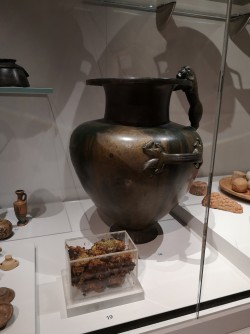Science
Researchers Confirm 2,500-Year-Old Residue Likely Ancient Honey

Archaeologists have long pondered the identity of a sticky substance discovered in a copper jar from an ancient Greek shrine. Recent research suggests that this residue is likely the remains of ancient honey, a conclusion that contradicts previous analyses. The findings were published in the Journal of the American Chemical Society by a team led by researchers Luciana da Costa Carvalho and James McCullagh.
The discovery traces back to 1954 when a Greek shrine, dating to around 520 BCE, was unearthed in Paestum, Italy, approximately 90 minutes from Pompeii. Archaeologists initially presumed that the sticky residue found in several bronze jars was honey, thought to be offered as honeycombs. However, subsequent examinations over three decades failed to confirm this, as three different research teams suggested that the jars contained animal or vegetable fats, contaminated with pollen and insect parts.
In a recent opportunity to reanalyze the residue at the Ashmolean Museum, the research team used modern analytical techniques to investigate its chemical composition. Their analysis revealed a chemical fingerprint nearly identical to that of both modern beeswax and honey. Notably, the acidity level was higher than typical for fresh honey, indicating changes from long-term storage.
The researchers identified several key components in the ancient residue. They found a more complex chemical makeup than that of degraded beeswax, suggesting the presence of honey or other bee products. Additionally, degraded sugars mixed with copper were detected where the residue had touched the bronze jar. The analysis also revealed higher concentrations of hexose sugars, commonly found in honey, compared to modern beeswax. Furthermore, proteins known to be secreted by the western honeybee, specifically royal jelly proteins, were also identified.
These results strongly indicate that the substance is likely ancient honey, although it is essential to note that the researchers could not completely rule out the presence of other bee products. “Ancient residues aren’t just traces of what people ate or offered to the gods — they are complex chemical ecosystems,” said da Costa Carvalho. “Studying them reveals how those substances changed over time, opening the door to future work on ancient microbial activity and its possible applications.”
The authors of the study acknowledge that no external funding was received for this research. The abstract of the paper will be available on July 30, 2025, at 08:00 Eastern Time.
The American Chemical Society (ACS), a nonprofit founded in 1876, is dedicated to advancing scientific knowledge and promoting excellence in science education. Through its various journals and research initiatives, ACS plays a leading role in disseminating scientific information to the global community.
-

 Technology5 months ago
Technology5 months agoDiscover the Top 10 Calorie Counting Apps of 2025
-

 Health3 months ago
Health3 months agoBella Hadid Shares Health Update After Treatment for Lyme Disease
-

 Health3 months ago
Health3 months agoErin Bates Shares Recovery Update Following Sepsis Complications
-

 Technology4 months ago
Technology4 months agoDiscover How to Reverse Image Search Using ChatGPT Effortlessly
-

 Technology1 month ago
Technology1 month agoDiscover 2025’s Top GPUs for Exceptional 4K Gaming Performance
-

 Technology3 months ago
Technology3 months agoElectric Moto Influencer Surronster Arrested in Tijuana
-

 Technology5 months ago
Technology5 months agoMeta Initiates $60B AI Data Center Expansion, Starting in Ohio
-

 Technology5 months ago
Technology5 months agoRecovering a Suspended TikTok Account: A Step-by-Step Guide
-

 Health4 months ago
Health4 months agoTested: Rab Firewall Mountain Jacket Survives Harsh Conditions
-

 Lifestyle5 months ago
Lifestyle5 months agoBelton Family Reunites After Daughter Survives Hill Country Floods
-

 Health3 months ago
Health3 months agoAnalysts Project Stronger Growth for Apple’s iPhone 17 Lineup
-

 Technology4 months ago
Technology4 months agoHarmonic Launches AI Chatbot App to Transform Mathematical Reasoning





















